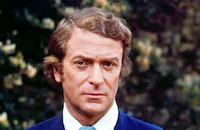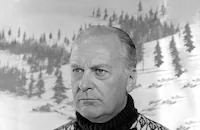Battle of Britain

Brief Synopsis
Cast & Crew
Guy Hamilton
Laurence Olivier
Robert Shaw
Christopher Plummer
Susannah York
Ian Mcshane
Film Details
Technical Specs

Synopsis
After the evacuation of Dunkirk and Britain's rejection of Hitler's offer for an armistice, the British hope to gain time to rearm for the inevitable clash with the Luftwaffe. Following Goering's plan to destroy British air power on the ground, the Luftwaffe attacks airfields in southern England, causing heavy losses. The RAF is able to fight back effectively, however, thus vindicating Air Chief Marshal Hugh Dowding's policy of maintaining protective strength in Britain during the battle for France. Continuous assaults by the Germans begin to place a strain on the RAF's most experienced pilots, such as Squadron Leaders Skipper and Harvey, and inexperienced fliers are hurriedly trained for the daily operations. When a German plane accidentally bombs London, the British retaliate by shelling Berlin; Hitler, furious that the enemy was able to penetrate his country, calls for the destruction of London and other British cities. The RAF uses the time of the blitzkrieg to rebuild the destroyed airfields and to regroup with the aid of the Polish Freedom Fighters; Goering's massive attack is met by a strong RAF, and the order to invade Britain is cancelled.

Director

Guy Hamilton
Cast

Laurence Olivier
Robert Shaw

Christopher Plummer

Susannah York
Ian Mcshane

Michael Caine

Kenneth More

Trevor Howard

Patrick Wymark

Ralph Richardson

Curt Jürgens

Harry Andrews

Michael Redgrave

Nigel Patrick
Michael Bates
Isla Blair
John Baskcomb
Tom Chatto
James Cosmo
Robert Flemyng

Barry Foster
Edward Fox
W. G. Foxley
David Griffin

Jack Gwillim
Myles Hoyle
Duncan Lamont
Sarah Lawson
Mark Malicz
André Maranne
Anthony Nicholls
Nicholas Pennell
Andrzej Scibor
Jean Wladon
Wilfried Van Aacken
Karl Otto Alberty
Alexander Allerson
Dietrich Frauboes
Alf Jungermann
Peter Hager
Wolf Harnisch
Reinhard Horras
Helmut Kircher
Paul Neuhaus
Malte Petzel
Manfred Reddemann
Hein Riess
Rolf Stiefel
Crew
Eric Allwright
Malcolm Arnold
Bert Bates
John Bennett
Maurice Binder
David Bracknell
Col. Hans Brustellin
Ray Caple
Maurice Carter
Derek Cracknell
Brenda Dabbs
Bert Davey
Squadron Leader B. Drobinski
Carl Duering
Gordon Everett
S. Benjamin Fisz
Maj. Franz Frodl
George Frost
Lt. Gen. Adolf Galland
Group Capt. Tom Gleave
Ron Goodwin
Wilfred Greatorex
Claud Hudson
Bob Huke
William Hutchinson
John Jordan
Skeets Kelly
James Kennaway
Squadron Leader Ginger Lacey
Wing Cmdr. Claire Legge
Group Capt. Hamish Mahaddie
Ted Mason
Jack Maxsted
Gordon Mccallum
John Palmer
Gil Parrondo
Agustin Pastor
Cliff Richardson
Glen Robinson
Harry Saltzman
Elaine Schreyeck
A. G. Scott
James Shields
Maude Spector
Wing Cmdr. Robert Stanford-tuck
Sydney Streeter
Wally Veevers
William Walton
Bernard Williams
John Wilson-apperson
Wing Cmdr. Robert Wright
Freddie Young

Videos
Movie Clip


Trailer
Film Details
Technical Specs

Articles
Battle of Britain
Battle of Britain (1969) is essentially this story, alternating personal vignettes of commanders, flyers and civilians with spectacular and vivid dogfight sequences. These combat scenes are the result of some impressive logistical coordination and craftsmanship, and they make the film visually compelling.
Producer Harry Saltzman and director Guy Hamilton, both known for their work on Goldfinger (1964) and other James Bond movies, oversaw 18 months of scripting and 14 months of shooting. They assembled over 100 vintage planes and hired as technical advisers three of the greatest veteran flying aces of the battle - two British and one German. They also had 14 movie stars in the cast, which made for a scheduling nightmare. It proved to be a real challenge to pull off an epic of this size while maintaining a clear and cohesive point of view for the audience. In the end, Battle of Britain tried to show too much, blunting its force with an episodic structure. Still, the dogfights look great, and the picture effectively evokes a sense of battle fatigue, anxiety over a pilot shortage, and the headaches of top military brass as they devise strategy with time running out.
Standing out in the enormous all-star British cast is Laurence Olivier as Sir Hugh Dowding, head of RAF Fighter Command, whose crafty tactics with his limited planes induced the Luftwaffe to make fatal errors. Dowding refused to be glibly optimistic, persuading Churchill to keep as many planes as possible in England in order to have a real chance at defeating the Nazis there. The real Hugh Dowding, then 86, visited the set and reportedly wept as he watched Olivier reenact his famous confrontation with Churchill, in which he told the Prime Minister, "Our young men will just have to shoot down their young men at the rate of five to one."
Trevor Howard, also quite good as the Air Vice-Marshall, relished the chance to work with Olivier. He said, "There's a man you admire all your life, hope to one day get to make a film with, and you do only two small scenes with him shot in about two or three days. But it was worth it, old son. And I've known Larry a long time."
Among the supporting players is Michael Caine who recalled in his autobiography, What's It All About? (Ballantine Books), that his "part was small, but I took it and how glad I was, because it gave me an opportunity to talk to some remarkable survivors of the Battle of Britain. I was privileged to meet two of the greatest British air aces of that battle: Ginger Lacey and Bob Stanford Tuck, who were on the film as technical advisers. Our German technical advisor was none other than Adolf Galland, the Nazi air ace who led the battle from the enemy side."
The Battle of Britain emerged in the middle of a spate of epic combat films which re-created specific battles of WWII with all-star international casts, actual locations and docudrama-like realism - films like The Longest Day (1962), In Harm's Way (1965), Tora! Tora! Tora! (1970), and Midway (1976). The combat genre had by now evolved from early propagandistic retellings of actual events to virtual replicas of those events, paying close attention to minute details of time and place. Cinematically, the war was now a legend.
Producer: Benjamin Fisz, Harry Saltzman
Director: Guy Hamilton
Screenplay: Wilfred Greatorex, James Kennaway
Cinematography: Freddie Young, Bob Huke
Film Editing: Bert Bates
Art Direction: Bert Davey, William Hutchinson, Jack Maxsted, Gil Parrondo, Maurice Carter
Music: Ron Goodwin, William Walton
Cast: Harry Andrews (Senior Civil Servant), Trevor Howard (Air Vice Marshal Keith Park), Michael Caine (Squadron Leader Canfield), Curd Jurgens (Baron Von Richter), Ralph Richardson (Sir David), Ian McShane (Sgt. Pilot Andy).
C-132m. Letterboxed.
by Jeremy Arnold

Battle of Britain
Quotes
But the essential arithmetic is that our young men will have to shoot down their young men at the rate of four to one, if we're to keep pace at all.- Air Chief Marshall Sir Hugh Dowding
The engine's overheating and so am I. Either we stand down or blow up. Now which do you want?- Squadron Leader Canfield
Never in the field of human conflict was so much owed by so many to so few.- Winston Churchill
Shut up! Silence - in Polish!- Squadron Leader Edwards
Well don't just stand there, get one up!- Squadron Leader Skipper
Trivia
The large number of aircraft collected for this production made it the 11th largest air force in the world.
27 Spitfires in various degrees of repair were found for the film, but only five Hurricanes, three of which were flyable. The Messerschmitts and Heinkels were on loan from the Spanish Air Force.
According to the book written about the making of the movie the production crew used more ammunition (blanks of course) to film the movie - due to the fact that directors re-shoot scenes numerous times - than was actually used in the real historical battle.
Adolf Galland, the Luftwaffe pilot who fought during Battle of Britain, who later became the youngest German general at the age of 29, was hired as a technical advisor.
American special effects creator 'John Fulton' was going to do the special effects for this film. He died in England before principal photography began.
There were to have been scenes featuring Lord Beaverbrook. Alec Guinness was hired to play Lord Beaverbrook, but these scenes were cut from the script shortly before filming.
Notes
Location scenes filmed at Duxford, Hawkinge, North Weald, and Northold airfields in England, and at the Tablana airfield in Spain. Opened in London in September 1969.

Miscellaneous Notes
Released in United States Fall September 15, 1969
Released in United States on Video January 10, 1989
Released in United States on Video January 10, 1989
Released in United States Fall September 15, 1969














